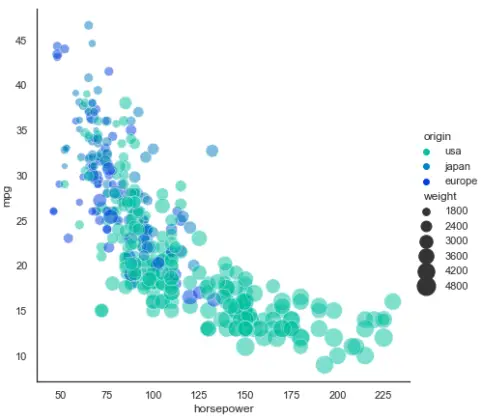

Next, create the box plot by using the method named boxplot() with object reference sns. Then it uses the random data using a list to depict the fake data. In the following example, we will start the program by importing the modules- seaborn and matplotlib.pyplot that helps to plot the graph diagram. Finally, it will use the method show() to get the output of the program. Then use the xlim() and ylim() to get the range limit of the integer on the x and y axes respectively.
Seaborn scatter plot axis range how to#
In the following example, we will show how to draw a histogram by using the built-in method histplot() which accepts the parameter as a variable named data which has random data, and using built-in functions like xlabel() and ylabel() it has set the text name on horizontal and vertical axis respectively. Next, use the show() method to get the result. In the following example, we will show the bar graph barplots() and to set the label and axes it has to use the following methods- xlabel(), ylabel(), ylim(). pyplot that helps to plot the graph and generate the output by giving a specific built-in method to it. It also uses the matplotlib submodule i.e. In the following example, we will show how to a lineplot diagram by setting label and limits using Seaborn plot. As we know Seaborn library is comfortable working with the matplotlib module and it will generate the diagram according to the given dataset. In the following example, we will show how a draw a scatterplot diagram by setting labels and limits. Step 7 − Finally use the method named show() that will generate the output of the program. Step 6 − To set the range of graph figure it will use the built-in method xlim() for horizontal axis and y-lim() for vertical axis. Step 5 − Next, create the text representation on horizontal(x-axis) and vertical axes(y-axis) by using the built-in methods xlabel() and ylabel() respectively. Step 4 − Then create the plot graph figure according to users choice such as scatterplot(), lineplot(), boxplot(), and, histplot() that accepts two parameters- x( this stores the value as variable x) and y( this store the value as variable y) with object reference sns. Step 3 − Create the two lists with random data and store it in the variable x and y respectively. Step 2 − Import the module named matplotlib.pyplot and take reference as plt that helps to set the axes label and limit of Seaborn plot. Step 1 − Import the seaborn module and take the object reference as sns The boxplot() method shows the high-level summary in a standardized way to summarise the data based on the dataset. The histplot() create the diagram based on the histogram according to dataset.

This is an in-built method in Python that will be used to create the bar graph of a dataset. This is a basic diagram that is mostly used in the machine learning dataset. The lineplot() method is used to show the interval of a plot. The scatterplot() is a built-in method in Python that helps set the dot figure of the graph based on the dataset. The xlim() and ylim() are the built-in functions that set the specified range on the x-axis and y-axis respectively. The xlabel() and ylabel() are the built-in functions in Python that set the text on x-axis(horizontal) and y-axis(vertical). The following syntax is used in the examples − xlabel() In Python, we have some built-in functions like xlabel(), ylabel(), xlim(), and, ylim() that can be used to set the axes labels and limits in a Seaborn plot. Seaborn includes straightforward methods for setting axis labels and boundaries that allow us to make our plots more informative.

We can focus on select areas of the data that are significant by altering the axes' limitations. The axes labels are the names we can provide to the x and y axes so that others can understand what the plots show. Plot_jointplot('tip', 'total_bill', np.log(data), (3.5, 3.Creating the plots using Seaborn will adjust the labels and axes limitations to make the plots more understandable. Graph = sns.jointplot(x='tip', y='total_bill', data=data, kind='reg', marginal_kws=) # log-scaled import seaborn as snsĭata = sns.load_dataset('tips')]**3 To log-scale the plots, another way is to pass log_scale argument to the marginal component of jointplot 1, which can be done via marginal_kws= argument.


 0 kommentar(er)
0 kommentar(er)
